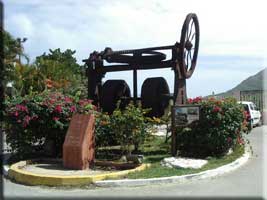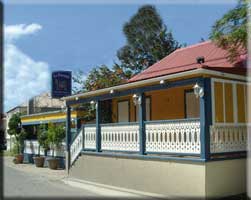Salt Press and Le Pressoir in Grand Case
The salt pond in Grand Case was the largest on the French side. On the left above is the press that crushed the salt crystals. In the early days, the pond was filled with salt water and the sun would evaporate the water, leaving salt crystals. The ships would make a circle, picking up slaves in Africa and making the passage to the Caribbean. They traded slaves for salt, cotton, and sugar (frequently in the form of rum!). These products would head for the US. Salt and slaves could be sold and cotton could be picked up in the southern states. In New England and eastern Canada, the salt was bartered for salted fish and the boats would return eastward across the frigid North Atlantic with salted fish, cotton, sugar, rum, and salt.
Things are vastly different now. The salt press hasn't been used in half a century but is now on display as the last remnant of that factory. Across the street, Le Pressoir Restaurant carries its name, serving fine French food in a beautifully restored Créole cottage. Grand Case map | St Martin map
|


